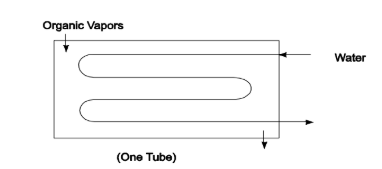Particle A (mass = m, charge = Q) and B (mass = m, charge = 5 Q) are released from rest with the distance between them equal to 1.0 m. If Q = 12 ?C, what is the kinetic energy of particle B at the instant when the particles are 3.0 m apart?
a. 8.6 J
b. 3.8 J
c. 6.0 J
d. 2.2 J
e. 4.3 J
d
You might also like to view...
The Great Nebula in Orion, M-42, is a low-density cloud of hot gas. Use Kirchhoff's laws to describe its spectrum
What will be an ideal response?
Which of the following best describes a sound level of intensity 1 W/m2?
a. extremely loud b. about that of a power mower c. normal conversation d. like a whisper
Determine the distance to Proxima Centauri in light-years, if it is 1.3 pc away
A horizontal shell-and-tube heat exchanger is used to condense organic vapors. The organic vapors condense on the outside of the tubes, while water is used as the cooling medium on the inside of the tubes. The condenser tubes are 1.9-cm-O.D., 1.6-cm-ID copper tubes, 2.4 m in length. There are a total of 768 tubes. The water makes four passes through the exchanger. Test data obtained when the unit was first placed into service are as follows
Water rate = 3700 l/min
Inlet water temperature = 29°C
Outlet water temperature = 49°C
Organic-vapor condensation temperature = 118°C
After 3 months of operation, another test, made under the same conditions as the first (i.e., same water rate and inlet temperature and same condensation temperature) showed that the exit water temperature was 46°C.
(a) What is the tube-side-fluid (water) velocity?
(b) What is the effectiveness, e-NTU, of the exchanger at the time of the first and second test.
(c) Assuming no changes in either the inside transfer coefficient on the condensing
coefficient, negligible shell-side fouling, and no fouling at the time of the first test,
estimate the tube-side fouling coefficient at the time of the second test.
GIVEN
• A shell-and-tube exchanger, organic vapors condensing in shell, water in copper tubes
• Tube diameters
? Do = 1.9 cm = 0.019 m
? Di = 1.6 cm = 0.016 m
• Tube length (L) = 2.4 m
• Number of tubes (N) = 768
• Number of tube passes (Np) =4
• Water flow rate v w= 3700 1/min = 3.7 m3/min
• Water temperatures
? Tw,in = 29°C
? Tw,out = 49°C
• Organic vapor condensation temperature (Tc) = 118°C
• After 3 months: Tw,out = 46°C
FIND
(a) Water velocity (Vw)
(b) The effectiveness (e) at the time of both tests
(c) Fouling coefficient (1/Ri) at the time of the second test
ASSUMPTIONS
• No fouling at the time of the first test
• No change in the inside and outside heat transfer coefficients
• Negligible shell-side fouling
• Length given is the length of one tube - all four passes
SKETCH

PROPERTIES AND CONSTANTS
for water at 40°C
Density (?) = 992 kg/m3 Specific heat (cpw) = 4175 J/(kg K)
Thermal conductivity (k) = 0.633 W/(m K)
Kinematic viscosity (?) = 0.658 × 10–6 m2/s
Prandtl number (Pr) = 4.3
the thermal conductivity of copper (kc) = 392 W/(m K) at 127°C.